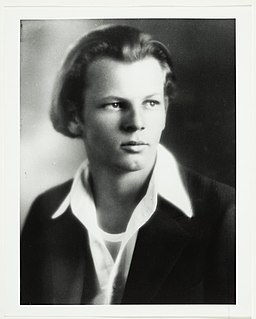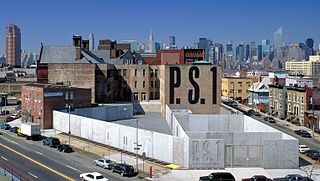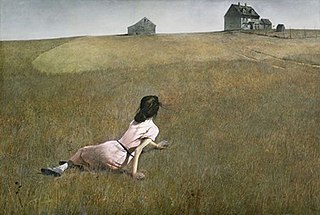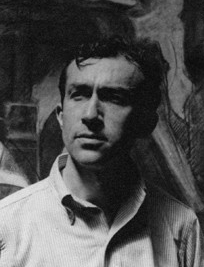
Paul Jackson Pollock was an American painter and a major figure in the abstract expressionist movement. He was widely noticed for his "drip technique" of pouring or splashing liquid household paint onto a horizontal surface, enabling him to view and paint his canvases from all angles. It was also called all-over painting and action painting, since he covered the entire canvas and used the force of his whole body to paint, often in a frenetic dancing style. This extreme form of abstraction divided the critics: some praised the immediacy of the creation, while others derided the random effects. In 2016, Pollock's painting titled Number 17A was reported to have fetched US$200 million in a private purchase.

Pablo Ruiz Picasso was a Spanish painter, sculptor, printmaker, ceramicist and theatre designer who spent most of his adult life in France. Regarded as one of the most influential artists of the 20th century, he is known for co-founding the Cubist movement, the invention of constructed sculpture, the co-invention of collage, and for the wide variety of styles that he helped develop and explore. Among his most famous works are the proto-Cubist Les Demoiselles d'Avignon (1907), and Guernica (1937), a dramatic portrayal of the bombing of Guernica by German and Italian air forces during the Spanish Civil War.

Henri Émile Benoît Matisse was a French artist, known for both his use of colour and his fluid and original draughtsmanship. He was a draughtsman, printmaker, and sculptor, but is known primarily as a painter. Matisse is commonly regarded, along with Pablo Picasso, as one of the artists who best helped to define the revolutionary developments in the visual arts throughout the opening decades of the twentieth century, responsible for significant developments in painting and sculpture.

The Museum of Modern Art (MoMA) is an art museum located in Midtown Manhattan, New York City, on 53rd Street between Fifth and Sixth Avenues.

Francis Picabia was a French avant-garde painter, poet and typographist. After experimenting with Impressionism and Pointillism, Picabia became associated with Cubism. His highly abstract planar compositions were colourful and rich in contrasts. He was one of the early major figures of the Dada movement in the United States and in France. He was later briefly associated with Surrealism, but would soon turn his back on the art establishment.
Abstract expressionism is a post–World War II art movement in American painting, developed in New York City in the 1940s. It was the first specifically American movement to achieve international influence and put New York at the center of the Western art world, a role formerly filled by Paris.

Pavel Fyodorovich Tchelitchew was a Russian-born surrealist painter, set designer and costume designer.

Adolph Dietrich Friedrich Reinhardt was an abstract painter active in New York for more than three decades. He was a member of the American Abstract Artists (AAA) and part of the movement centered on the Betty Parsons Gallery that became known as abstract expressionism. He was also a member of The Club, the meeting place for the New York School abstract expressionist artists during the 1940s and 1950s. He wrote and lectured extensively on art and was a major influence on conceptual art, minimal art and monochrome painting. Most famous for his "black" or "ultimate" paintings, he claimed to be painting the "last paintings" that anyone can paint. He believed in a philosophy of art he called Art-as-Art and used his writing and satirical cartoons to advocate for abstract art and against what he described as "the disreputable practices of artists-as-artists".
Robert Motherwell was an American abstract expressionist painter, printmaker, and editor. He was one of the youngest of the New York School, which also included Willem de Kooning, Jackson Pollock, and Mark Rothko.

MoMA PS1 is one of the largest art institutions in the United States dedicated solely to contemporary art. It is located in Court Square in the Long Island City neighborhood in the borough of Queens, New York City. In addition to its exhibitions, the institution organizes the Sunday Sessions performance series, the Warm Up summer music series, and the Young Architects Program with the Museum of Modern Art. MoMA PS1 has been affiliated with the Museum of Modern Art since January 2000 and, as of 2013, attracts about 200,000 visitors a year.

Dorothea Margaret Tanning was an American painter, printmaker, sculptor, writer, and poet. Her early work was influenced by Surrealism.

Christina's World is a 1948 painting by American painter Andrew Wyeth and one of the best-known American paintings of the mid-20th century. It is a tempera work done in a realist style, depicting a woman semi-reclining on the ground in a treeless, mostly tawny field, looking up at a gray house on the horizon; a barn and various other small outbuildings are adjacent to the house. It is owned by the Museum of Modern Art in New York as part of its permanent collection.
Charles Henri Ford was an American poet, novelist, diarist, filmmaker, photographer, and collage artist. He published more than a dozen collections of poetry, exhibited his artwork in Europe and the United States, edited the Surrealist magazine View (1940–1947) in New York City, and directed an experimental film. He was the partner of the artist Pavel Tchelitchew.

Fine-art photography is photography created in line with the vision of the photographer as artist, using photography as a medium for creative expression. The goal of fine-art photography is to express an idea, a message, or an emotion. This stands in contrast to representational photography, such as photojournalism, which provides a documentary visual account of specific subjects and events, literally representing objective reality rather than the subjective intent of the photographer; and commercial photography, the primary focus of which is to advertise products, or services.

Hyman Bloom was a Latvian-born American painter. His work was influenced by his Jewish heritage and Eastern religions as well as by artists including Altdorfer, Grünewald, Caravaggio, Rembrandt, Blake, Bresdin, Ensor and Soutine. He first came to prominence when his work was included in the 1942 Museum of Modern Art exhibition "Americans 1942 -- 18 Artists from 9 States". MoMA purchased 2 paintings from the exhibition and Time magazine singled him out as a "striking discovery" in their exhibition review.

Dorothy Canning Miller was an American art curator and one of the most influential people in American modern art for more than half of the 20th century. The first professionally trained curator at the Museum of Modern Art (MoMA), she was one of the very few women in her time who held a museum position of such responsibility.

Thelma Beatrice Johnson Streat was an African-American artist, dancer, and educator. She gained prominence in the 1940s for her art, performance and work to foster intercultural understanding and appreciation.

Joseph Hirsch (1910–1981) was an American painter, illustrator, muralist and teacher. Social commentary was the backbone of Hirsch's art, especially works depicting civic corruption and racial injustice.

Girl before a Mirror is an oil on canvas painting by Pablo Picasso, which he created in 1932. The painting is a portrait of Picasso's mistress and muse, Marie-Thérèse Walter, who is depicted standing in front of a mirror looking at her reflection. It is housed in the collection of the Museum of Modern Art in New York City.
Andrew Carnduff Ritchie (1907–1978) was a Scottish-born American art historian specialising in British 18th-century sculpture, a professor, museum director and post-World War II 'Monuments Man'. He was the director of the Albright-Knox Art Gallery in Buffalo, N.Y., director of Painting and Sculpture at the Museum of Modern Art, and director of the Yale University Art Gallery.
















